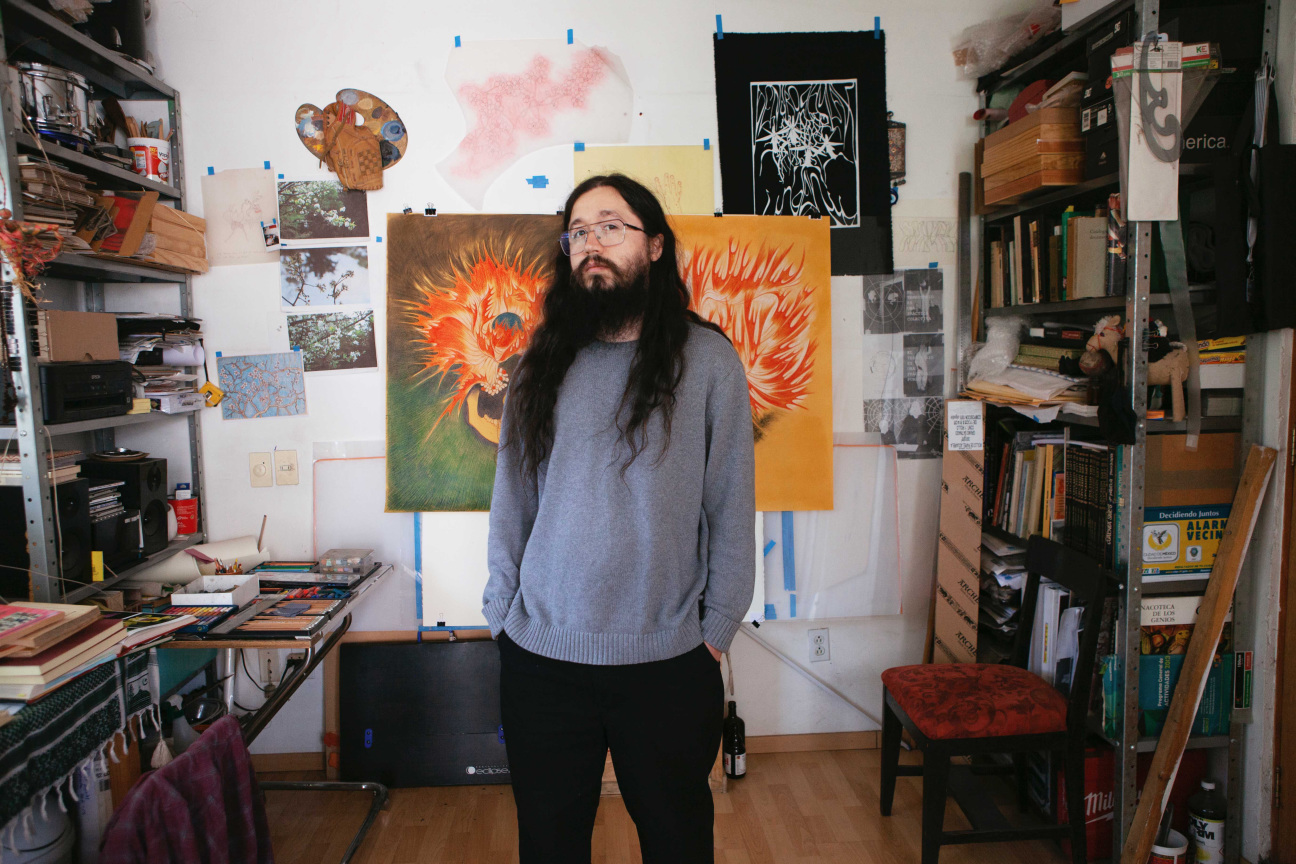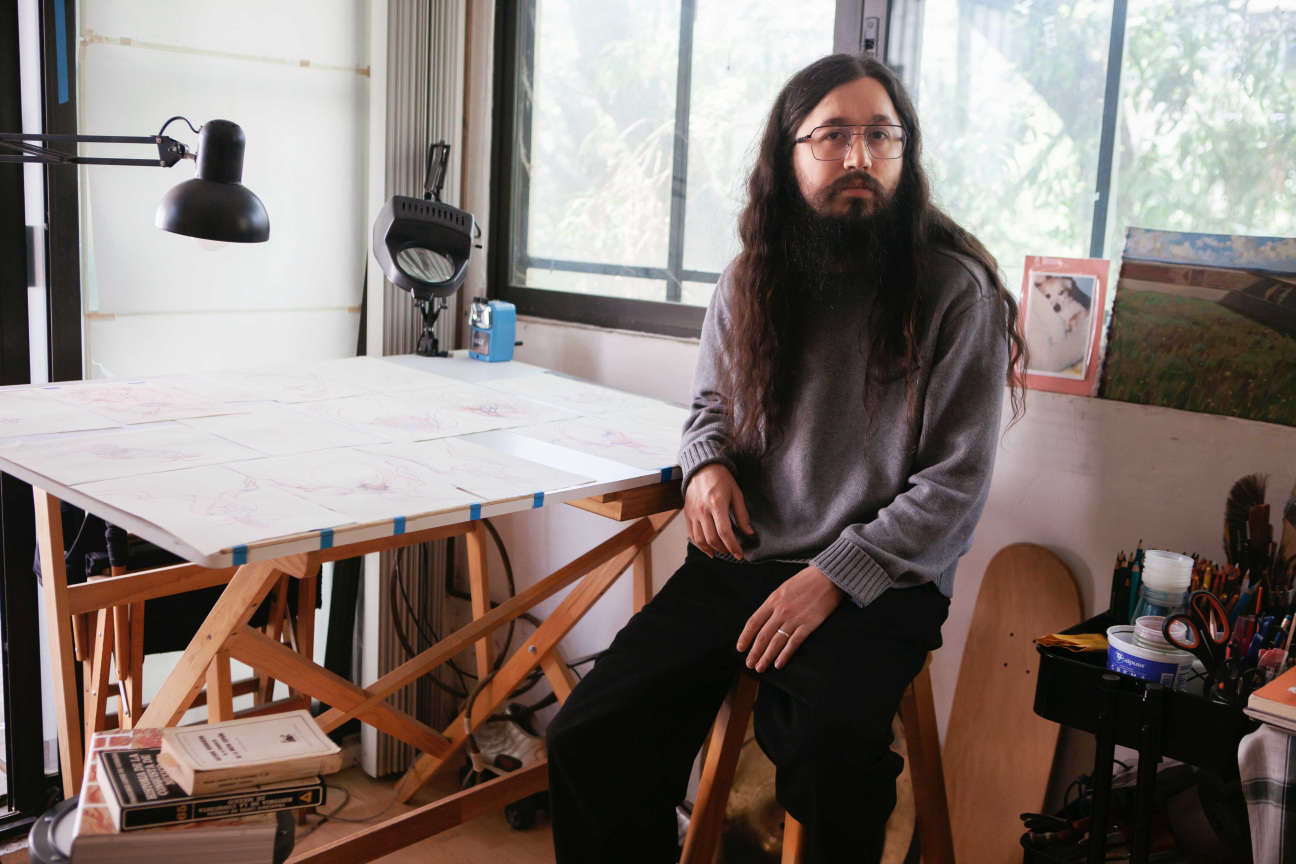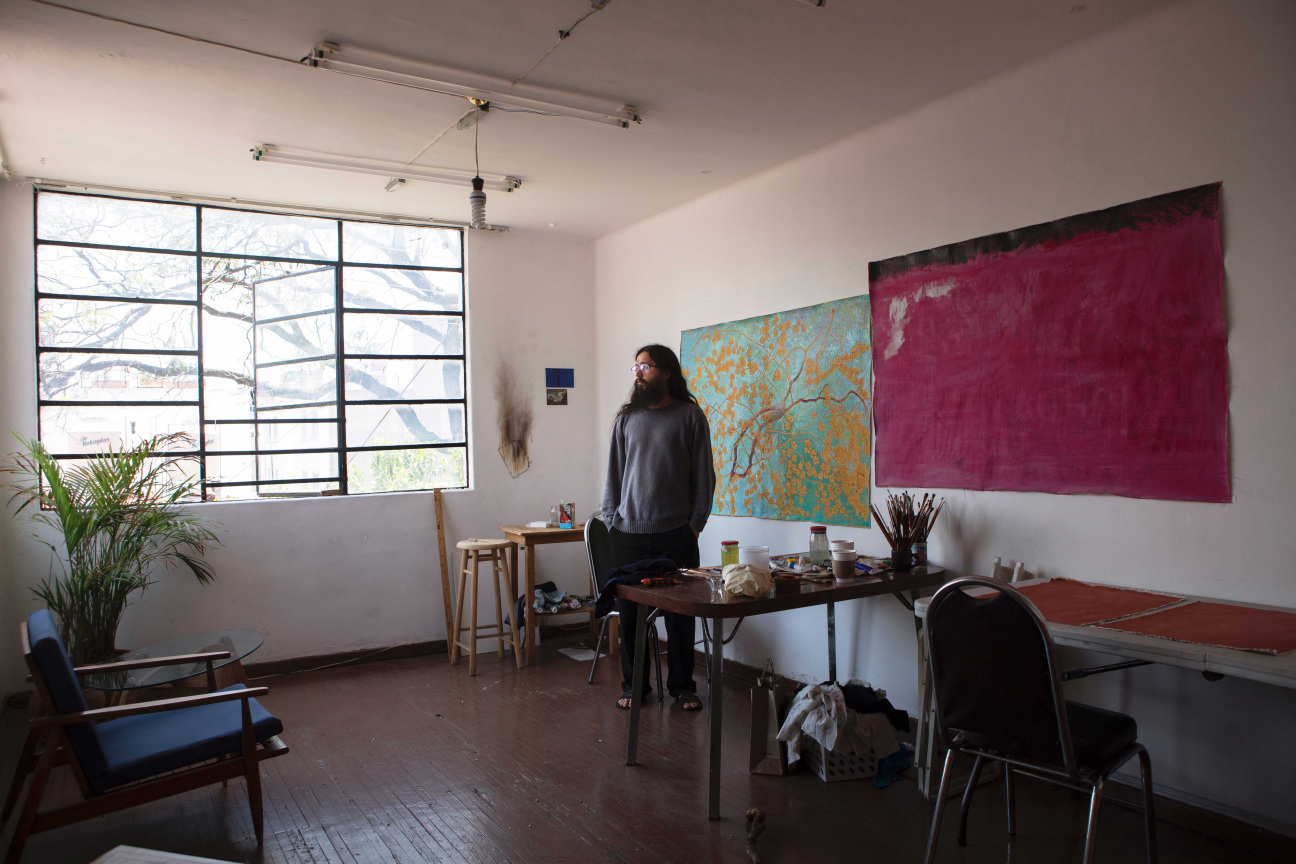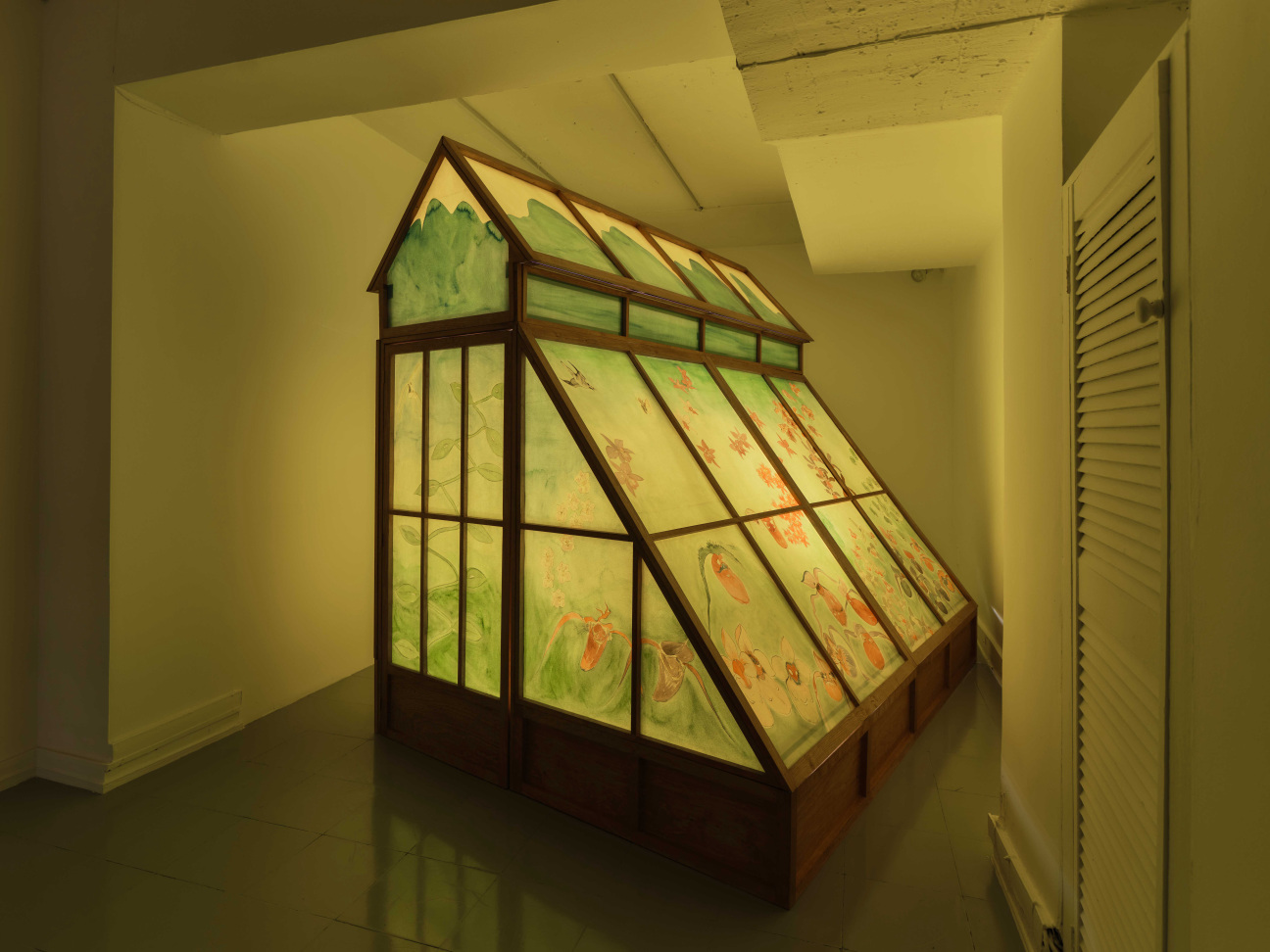
Javier Barrios doesn't know how old he was when he first stared up at José Clemente Orozco’s menacing murals at the Hospicio Cabañas in Guadalajara. The vaulted hellscape lives rent-free in the artist’s psyche anyway. As a child, he and his siblings would dodge scorching squares of sun as they ran along the porticos downtown before seeking reprieve in the cold, domed chapel where, in the 1930s, the Mexican muralist realized 57 separate vignettes across the ceiling.
A Gesamtkunstwerk embedded with veiled allegories from Mexico’s history, Orozco’s murals depict a violent world on the verge of collapse, a place where peaks of sailing ships are almost indistinguishable from the furious seas that whip them: a kingdom made of line and flame.
On a hot fall day, I strained my neck to examine Man of Fire, the central panel in Orozco’s riddled composition, in which a man appears to be either slipping into a fiery abyss or summoning it to life. Nearby, images of landscape and pain mingle: Severed torsos could be confused with rocks, and buildings cringe in agony. If you know Barrios’s botanical drawings of ferociously faced orchids and petal-ringed skulls, it is easy to see why the Mexico City–based artist calls Orozco his compass.

“He’s one of those artists that every time I feel lost, I look at the work and I’m like, Okay, maybe this way,” says Barrios. Part of what makes Orozco Barrios’s patron saint is the career he cut as both an insider and an outsider. Like his peers Diego Rivera and David Alfaro Siqueiros, Orozco was employed by the Mexican government, but he wasn’t very successful at bolstering its reputation—he was too busy being a genre-defining visionary.
More than his contemporaries, Orozco commandeered the mural as a form that could handle the kind of gray area not typically afforded by politics. Orozco’s grotesque hybrids—knights riding horses with two heads or mechanical haunches—embody both humor and despair. Barrios displays a similar passion for loaded ambiguities.
His drawings of hybrid flower monsters, in their John James Audubon specificity and Hayao Miyazaki ingenuity, scare up images of colonial looting and cultural extraction without ever referencing them by name. Beautiful ends cannot be separated from their violent means.

Barrios looks to visual culture where beauty and death’s codependency is emphasized. The artist has an affection for Sunday cartoon strips, where characters infinitely die and respawn. He is a lover of Jigoku Zoshi, the 12th-century Buddhist hell scrolls, and the fiery, grinning demons they depict.
He playfully connects the language of Japanese anime to that of Mexican artists like Orozco. “They both put strong, unlike images together but in a very funny way that reinforces both. I admire work that can do multiple things at once,” says Barrios. “People assume illustrations of hell are disconnected from botany, but I can see there are some things that they could teach each other."
I first encountered Barrios’s work at the Drawing Center in New York. A cluster of his yellow paper monsters were the standout for me in a year-topping 2022 group show organized by the Walker Art Center’s curator of visual arts, Rosario Güiraldes, titled “Drawing in the Continuous Present.”

The exhibition addressed the bifurcated thinking on what makes a drawing a drawing, manifested by two seminal exhibitions: Connie Butler’s 1999 survey “Afterimage: Drawing Through Process,” at Los Angeles’s Museum of Contemporary Art, and artist Laura Hoptman’s “Drawing Now: Eight Propositions,” which she guest-curated at the Museum of Modern Art in 2002.
Güiraldes digested both schools of thought—drawing as a verb and a noun—and proposed her own “both/and” synthesis: Drawing is neither a process nor a product, but a multifaceted tool for fantasizing, translating, and spiritualizing. In Barrios’s furious and loose images of Frankenstein flowers on his signature manila paper, Güiraldes found an expression of her argument. “Drawing is beyond art. It is language,” Barrios tells me.
We are sitting in the living room of his Condesa apartment in Mexico City; its casual magnificence would make any digital nomad blush. Every available surface is adorned with either life or art. Cartoons and books on ancient civilization are stacked so high that they are indecipherable from the furniture. Sheets of paper are everywhere, and Barrios is the weight holding it all down. He milks a pause and then says, “Of course, I love art. I love art-making. I love being an artist … but drawing came before, and it’s going to be there after. If art ends in the future, drawing will survive.”

Drawing as a survival strategy is something that traces back to Barrios’s earliest days. His mother used to line the walls of their home with manila paper so that instead of scolding her children for making a mess, they could make the world their own. A few years later, Barrios’s mother signed him up for Sunday afternoon art classes. The other students were adults; he was 14. It was in this senior citizen painter’s circle that Barrios found his first mentors, people who spoke his language.
How many sheets of paper have drifted through Barrios’s life? It would need to be weighed in tons. He used to buy it by the kilo. One day, when he ran out of white paper for class, he grabbed some of the manila paper his mother still had handy. He found in its yellowness an old friend; it would become a key part of his practice.

“In school, my teachers used to tell me that it wasn’t a good idea to make art from this naive attitude of creativity and that I had to study,” says Barrios. “I still research, but I’m trying to not talk too much about it.” His books nod in silent reply. A departure from the chokehold that conceptualists like Gabriel Orozco and Abraham Cruzvillegas had on the 1990s Mexican scene, Barrios’s drawing for drawing’s sake is almost heretic. “Sometimes I even felt selfish about still working with [the orchids] because it’s so satisfying that I even feel I’m being lazy not trying different things,” he admits.
The truth is that Barrios has already exhausted other avenues, and his house is full of proof. He makes zines, sculptures, drawings, and paintings, which all coalesce in the jungle he shares with his anthropologist partner, Montserrat Pérez Castro.

My favorite detail of the place is the halo of orchids that rings Barrios’s studio across the breezeway from his kitchen. Mug in hand, he opens the door and we look at a work in progress pinned to the wall like a butterfly. The little, verdant office reminds me of Invernadero, 2022, Barrios’s greenhouse sculpture that went on view across town last fall at his Mexico City gallery, Pequod Co. The uncomfortably large dollhouse operates like a lightbox, transforming his sinister watercolors into a Josef Frank–like paper lantern.
Barrios points to one of the razor-faced blossoms in front of us and cracks a textbook on pre-Columbian art. Lately, his attention has landed on sacrificial obsidian knives produced in central Mexico in the14th and 15th centuries. “These knives show the profile of a face with eyes and teeth,” explains Barrios. “Teeth were related with fertility and seeds, and so the act of cutting the chest with the tooth side of the knife was also interpreted as a type of planting. The act of taking life was the same motion as creating it.”
These fecund weapons are the driving force behind Barrios’s first solo show with Clearing, "Offerings to the Nocturnal Hours," which opens in Brussels on September 7. At the time of my visit, the beginnings of the exhibition are just starting to sprout, with Barrios tending them like a careful gardener. Each one is an evolving affirmation of life, happily licking death in the face.










 in your life?
in your life?

